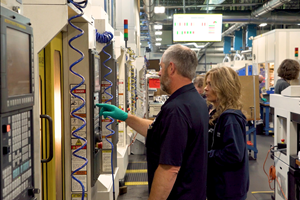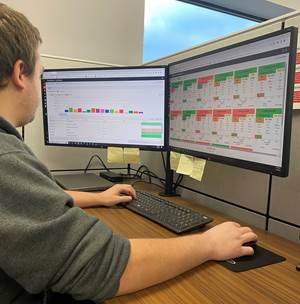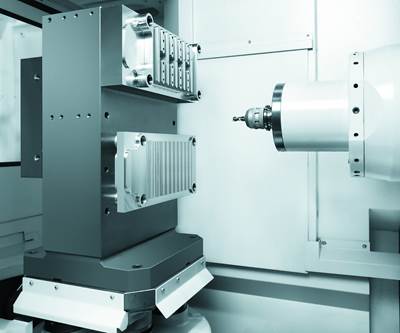Leveraging Data to Drive Manufacturing Innovation
Global manufacturer Fictiv is rapidly expanding its use of data and artificial intelligence to help manufacturers wade through process variables and production strategies. With the release of a new AI platform for material selection, Fictive CEO Dave Evans talks about how the company is leveraging data to unlock creative problem solving for manufacturers.
Share




If the currency of artificial intelligence (AI) is data, global manufacturer Fictiv is holding the king’s ransom. Fictiv co-founder and CEO Dave Evans calls the company an “operating system for custom manufacturing” — a company that simplifies sourcing for custom manufacturing by finding, vetting and managing suppliers; and by obtaining quotes and tracking orders across four global regions. The company states that it has produced 30 million parts over the course of 10 years, amassing volumes of data from computational geometry analysis performed on these parts and how each will be produced in the real world.
When I learned that Fictiv had just launched Materials.AI — a new AI assistant that pairs the company’s own AI algorithms with ChatGPT-4 to provide users with detailed material suggestions — I reached out to Evans and asked the former Forbes 30-Under-30 honoree about AI’s growing role in the company, including its existing AI platforms for quoting and design-for-manufacturing (DFM).
Modern Machine Shop: First let’s talk about Materials.AI: What is it, who is it for and why is it needed?
Dave Evans: Materials.AI really developed from our customers. We’ve been able to leverage the advancements of these large language models and AIs through custom solutions using our data. We’ve produced 30 million parts over 10 years, and when those part specifications are uploaded to Fictiv, we do a computational geometry analysis that simulates how this part will be made in the real world. For example, when a part is uploaded, we’ll know it’s a four-op part that takes two hours of machine time and will require two reamers and a T-slot cutter. We can then feed this data into our AI algorithms that we've layered on top of ChatGPT-4 and allow users to ask our platform very broad or very specific questions.
MMS: Can you share an example from the questions you’ve received so far?
Evans: Sure. So the latest question is, “What is the difference between hardening and heat treatment?” Typically, that would be a question that someone discusses with an application engineer to explain techniques for using heat treatment. But we think democratizing this process unlocks a lot of potential in the market.
MMS: How do you see these kinds of AI applications addressing labor concerns for the machining industry?
Evans: Do you still have a copy of Machinery’s Handbook on your desk? It's still the reference manual, right? Whether you’re a junior engineer or you’ve been doing this for multiple decades, that’s still our source of truth. But it’s also a big barrier to entry. Fortunately, we can take the information from that handbook and add real-world data from millions of parts across several industries. We can see people’s questions and how they’re resolved. All of this information is like Machinery’s Handbook, but with millions of use cases that add real-world context. We think that’s a profound way to bring value to the industry.
MMS: I imagine that you’re using AI for the quoting process in much the same way — by simulating the manufacture of a part.
Evans: That’s right. Simulating several ways that a part can be manufactured. There are many ways to make most parts, but there’s probably an optimal way to do it based on the variables that are important to you. Our algorithms are not just looking at, say, a rough bounding box and asking, “How did someone buy this in the past?” We know it’s a four-op part with these specific cutters, and we’re refining that algorithm over time. We look at raw material stock, runtime, whether it needs soft jaws, special tooling, etc., and we do that across the board. For injection molding, we can use AI to determine what sliders are needed, what kind of gates, what type of cooling systems and so on. With additive, we look at build beds, support material — all these algorithms are process-specific.
MMS: I assume most people aren’t willing to let AI dictate their manufacturing process completely, right?
Evans: In theory, they could take information from the AI chat and run with it, but what you’ll see at the end of the chat is an icon of one of our application engineers basically asking if you want to confirm or if you want to talk to one of our engineers on staff. The brand promise that got Fictiv to where we are today is that there is always a human in the loop. These tools are meant to assist. They’re not a replacement for that human conversation.
MMS: At Modern, we’ve talked a lot about perceptions around automation — the worry that automation replaces jobs and the counterargument that automation changes the nature of a person’s work. But I do have to wonder whether Fictiv’s expanding use of AI causes any concern around the office?
Evans: I think it’s a fair question. At Fictiv, we want to unlock people’s creative potential. We know that what AI is going to solve for us is not the creative work. When you ask our engineers who work with customers, they’re beyond excited. Because now, instead of looking up figures in a datasheet — the thicknesses of that Mil-Spec for example — they have a tool that will look that up to say, “Okay, now that we know that thickness and the tolerance you’re looking at, how can we solve this problem?” And solving problems requires creativity. The same way robots aren’t going to replace all workers, but instead allow knowledge workers to level up. AI allows engineers to be even more creative. That’s the power.
Related Content
Shop Quotes Smarter, Works Harder with Machine Monitoring
Temco first installed MT-LINKi to optimize quoting. Now, the software helps the shop optimize its machines — and machine purchases.
Read MoreMachine Monitoring Boosts Aerospace Manufacturer's Utilization
Once it had a bird’s eye view of various data points across its shops, this aerospace manufacturer raised its utilization by 27% in nine months.
Read MoreManufacturer, Integrator, Software Developer: Wolfram Manufacturing is a Triple Threat
Wolfram Manufacturing showcased its new facility, which houses its machine shop along with space for its work as a provider of its own machine monitoring software and as an integrator for Caron Engineering.
Read MoreProcess Control — Leveraging Machine Shop Connectivity in Real Time
Renishaw Central, the company’s new end-to-end process control software, offers a new methodology for producing families of parts through actionable data.
Read MoreRead Next
Using AI to Predict CNC Machine Spindle Issues Before They Are Issues
A machine tool builder is using artificial intelligence technology to predict when a spindle problem might occur, so shops can better prepare for and schedule necessary maintenance.
Read MoreSetting Up the Building Blocks for a Digital Factory
Woodward Inc. spent over a year developing an API to connect machines to its digital factory. Caron Engineering’s MiConnect has cut most of this process while also granting the shop greater access to machine information.
Read MoreBuilding Out a Foundation for Student Machinists
Autodesk and Haas have teamed up to produce an introductory course for students that covers the basics of CAD, CAM and CNC while providing them with a portfolio part.
Read More























.jpg;maxWidth=300;quality=90)







